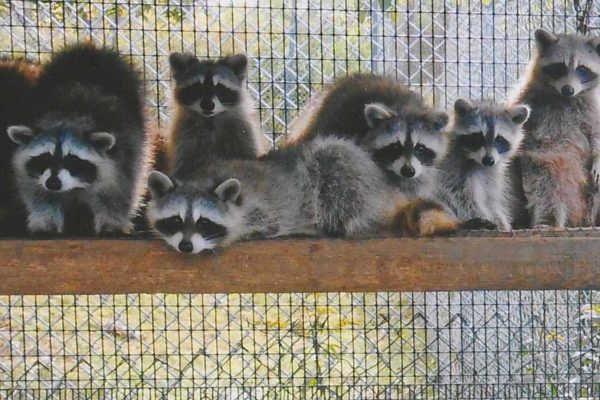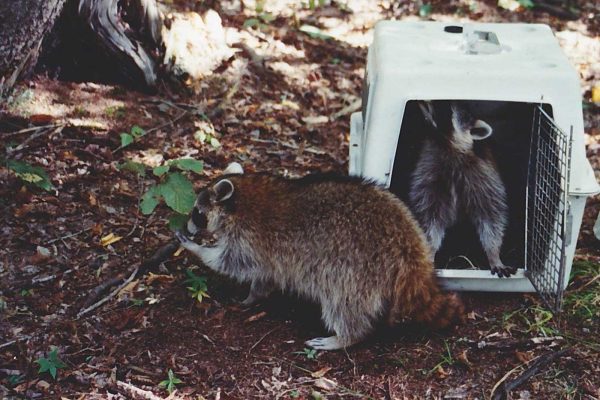
Young raccoons. Photo from Duck Pond Wildlife Center archives
When I stopped by to chat with Don at the Duck Pond Wildlife Care Center today, I expected to see the usual pet carriers and cages with rescued critters in the living room. I was surprised to find no one in the incubators or cages! Sadly, the chipmunk that had been admitted last week with injuries from a dog bite didn’t survive. The litter of four red squirrels brought in a few days ago has been transferred to another rehabber for the extra feeding and care needed for such small ones. The most recent admission is a young raccoon that had been found in a barrel; it seems to be in good condition other than being dehydrated and hungry, so after a few more days of fluids and food, will be released. Outside pens are currently housing several red foxes and one gray; the three fawns I mentioned in last month’s article have been transferred together and continue to flourish at their new rehab facility.
Don is planning to release three of the red foxes and the gray next week. I looked through some old columns and rather than re-invent the wheel, thought I’d share a portion of one written by the late Carleen Cote in 1996 about release sites:
“Our gratitude can’t be expressed enough to the landowners who have allowed us to enter their properties to release critters. To protect their privacy and the animals, we do not reveal where any of the critters are released. Without the landowners’ generosity, finding appropriate sites would be difficult, maybe impossible.
“For the mink and skunks who are usually released in August, we always find a source of water: marsh, beaver bog, or stream. The mink scurry into the water, diving and splashing, swimming away with nary a look back. The skunks immediately start grubbing, looking for their natural food of slugs and insects.
“The release sites we have selected for raccoons [and foxes] are deep in the woods, away from people. We never know how close we will be able to drive into the site; in many places, a trek by foot is needed to arrive at a source of water. So, a wheelbarrow is tied onto the cap of the truck to use for transporting the raccoons, safe in a dog kennel, through the woods. We learned early on that carrying a kennel with four or five raccoons weighing 10-15 pounds each was a task we didn’t want to repeat! The trek could be through water, brush piles, and over fallen trees – quite an obstacle course. The beauty and serenity of being alone in the woods, listening to the singing birds and rushing waters from a nearby brook is spoiled only by the buzzing, biting mosquitoes and deer flies. We soon reach our destination and prepare to say farewell to the raccoons we have cared for over the last five months. The raccoons cautiously emerge from the kennel. Some stop to look around, others dive into the water or start climbing a tree. We leave three to four days’ supply of food and say, ‘Good-bye and good luck!’ As happens every year when we have made the last trek into the forest… I say to my husband, Donald, ‘Do you know what I’m thinking?’ He says, ‘Yeah! What will we get next year?’ He’s right!”

Raccoons being released back into the wild. Photo courtesy Duck Pond Wildlife Center archives
As noted above, other rehabbers are generously providing assistance to help keep critter care at Duck Pond manageable. They are greatly appreciated! Please check the following websites to see if there is a rehabber near you: www.mainevetmed.org/wildlife-rehabilitation or www.maine.gov/ifw/fish-wildlife/wildlife/living-with-wildlife/orphaned-injured-wildlife/index.html
Donald Cote operates Duck Pond Wildlife Care Center on Rte. 3 in Vassalboro. It is a nonprofit, State-permitted rehab facility, which is supported by his own resources and outside donations. Mailing address: 1787 North Belfast Avenue, Vassalboro ME 04989 Phone: (207) 445-4326. Please note that the prior wildlifecarecenter email address is no longer monitored.
—by Jayne Winters, Natural Resources Council of Maine member from South China, Maine
Critter Chatter also appears monthly in the Town Line newspaper.










Leave a Reply